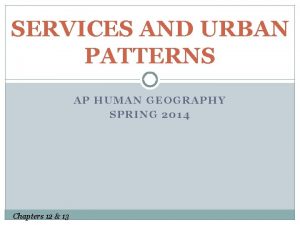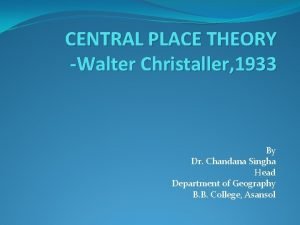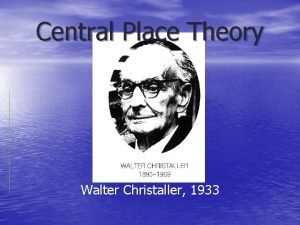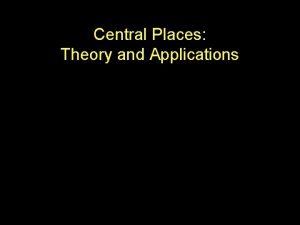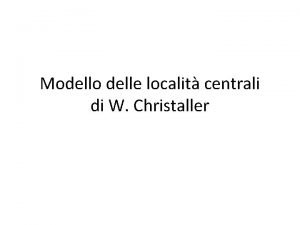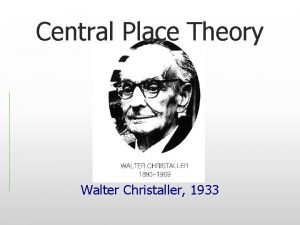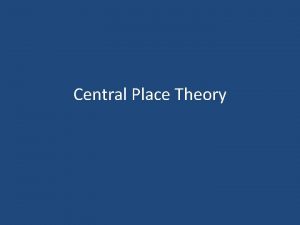Central Place Theory Central place theory Walter Christaller






- Slides: 6

Central Place Theory Central place theory: Walter Christaller, The Central Places in Southern Germany (1933), had five assumptions: 1. The surface of the ideal region would be flat and have no physical barriers. 2. Soil fertility would be the same everywhere 3. Population and purchasing power would be evenly distributed. 4. The region would have a uniform transportation network to permit direct travel from each settlement to the other. 5. From any given place, a good or service could be sold in all directions out to a certain distance. © 2012 John Wiley & Sons, Inc. All rights reserved.

Central Place Theory • Each central place has a surrounding complementary region, an exclusive trade area within which the town has a monopoly on the sale of certain goods. Hexagonal Hinterlands • Christaller chose perfectly fitted hexagonal regions as the shape of each trade area. © 2012 John Wiley & Sons, Inc. All rights reserved.

Where Are Cities Located, and Why? Central Places Today • New factors, forces, and conditions not anticipated by Christaller’s models and theories make them less relevant today. • Ex. : The Sun Belt phenomenon: the movement of millions of Americans from northern and northeastern states to the South and Southwest. © 2012 John Wiley & Sons, Inc. All rights reserved.

Modeling the North American City • Concentric zone model: resulted from sociologist Ernest Burgess’s study of Chicago in the 1920 s. Burgess’s model divides the city into five concentric zones, defined by their function: 1. CBD is itself subdivided into several subdistricts. 2. Zone of transition is characterized by residential deterioration and encroachment by business and light manufacturing. 3. Zone 3 is a ring of closely spaced but adequate homes occupied by the blue-collar labor force. 4. Zone 4 consists of middle-class residences. 5. Zone 5 is the suburban ring. © 2012 John Wiley & Sons, Inc. All rights reserved.

Modeling the North American City • Homer Hoyt: Sector model • The city grows outward from the center, so a low -rent area could extend all the way from the CBD to the city’s outer edge, creating zones that are shaped like a piece of pie. • The pie-shaped pieces describe the high-rent residential, intermediate rent residential, low-rent residential, education and recreation, transportation, and industrial sectors. © 2012 John Wiley & Sons, Inc. All rights reserved.

Modeling the North American City • Chauncy Harris and Edward Ullman: multiple nuclei model • This model recognizes that the CBD was losing its dominant position as the single nucleus of the urban area. • Edge cities: Suburban downtowns developed mainly around big regional shopping centers; they attracted industrial parks, office complexes, hotels, restaurants, enter-tainment facilities, and sports stadiums. © 2012 John Wiley & Sons, Inc. All rights reserved.
